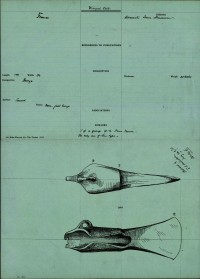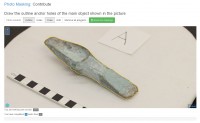Okay, I promise I’m not actively working to ensure that none of you ever leave your homes again. After all, there are always laptops, coffee shops with free wifi and libraries. It’s just that I can’t get enough of really fiddly detail work that helps bring hoary old museum collections into the Internet era.
 In this case the collection is the British Museum’s hoards of Bronze Age metal objects and thousands of index cards documenting other pre-historic metal objects. In collaboration with University College London, the museum has created a crowdsourcing platform that gives history nerds with OCD and time on their hands the chance to digitize the objects and records.
In this case the collection is the British Museum’s hoards of Bronze Age metal objects and thousands of index cards documenting other pre-historic metal objects. In collaboration with University College London, the museum has created a crowdsourcing platform that gives history nerds with OCD and time on their hands the chance to digitize the objects and records.
This record contains over 30,000 Bronze Age tools and weapons that were discovered during the 19th and 20th centuries, and complements the current Portable Antiquities Scheme (PAS) database of metal object finds.
The catalogue contains index cards detailing object find spots and types, alongside detail line drawings and a wide range of further information about the object’s context of discovery. The catalogue itself also has a long and special history. It was a major archaeological initiative first founded in 1913 and then moved to the British Museum in the 1920s. For over 70 years, it represented the highest standards of Bronze Age artefact studies.
“This information has long been known to be an extremely important untapped resource,” says curator Wilkin, “Metal finds are not only crucial forms of evidence for dating Britain’s prehistoric past, but also tell us a great deal about prehistoric society and economy. Once we have digitised the thousands of objects in this catalogue, they can be incorporated into the Portable Antiquities Scheme (PAS) website. The result will be the largest national database of prehistoric metal finds anywhere in the world and a near-comprehensive view of what we currently know about such finds in the UK. This will allow rethinking of almost everything we currently know about the use of metal in Bronze Age Britain, giving us a far more comprehensive view of our prehistoric past.”
Here’s the crowdsourcing website where the magic happens. They’ve already done the hard work of scanning all these records, but to make them searchable and categorizable in an online database, the handwritten information needs to be entered into standard fields. Character recognition is still fairly unreliable which is why our eyeballs and fingers are necessary to make this great project come together. I’ve done a handful of cards and found them eminently readable. There are no doctor’s scribbles or chickenscratch. The only part that can be a little challenging is when the fields on the index cards don’t match the database fields, and that’s a minority of the records.
 If data entry sounds a little dry an occupation for your free time, the project has a another goal of creating 3D models of Bronze Age artifacts in the British Museum. All you have to do to contribute to this goal is draw an outline around an artifact in a scanned photograph. It’s like the lasso tool in Photoshop. You click around the edge of the object every time the angle changes creating a polygonal outline. If the shape is odd and you feel the need to make multiple overlapping polygons, that works too. They don’t want any background pixels surrounding the artifact — they have dozens of pictures of each object to create the 3D model, so any slender losses along one edge will be recovered from a different view — so be sure to click along the inside edge rather than the outside.
If data entry sounds a little dry an occupation for your free time, the project has a another goal of creating 3D models of Bronze Age artifacts in the British Museum. All you have to do to contribute to this goal is draw an outline around an artifact in a scanned photograph. It’s like the lasso tool in Photoshop. You click around the edge of the object every time the angle changes creating a polygonal outline. If the shape is odd and you feel the need to make multiple overlapping polygons, that works too. They don’t want any background pixels surrounding the artifact — they have dozens of pictures of each object to create the 3D model, so any slender losses along one edge will be recovered from a different view — so be sure to click along the inside edge rather than the outside.
You can register on the website if you want your work credited to a single account and if you’d like to seek help/fellowship on the community forum, but you don’t have to register to help out. Just click on an application and dive right in. A window will pop up with instructions. Once you get into a record, there are further tips in the database fields and on the photographs to help you out as you go along.
I found it meditative and genuinely enjoyable. There are some beautiful drawings of the artifacts on the index cards, and it’s amazing to see the remote areas where these artifacts have been found. Out of the five I did, three of them were from outside of the UK (two from France, one from Hungary). Every card and picture is a micro-lesson in the Bronze Age archaeological record.